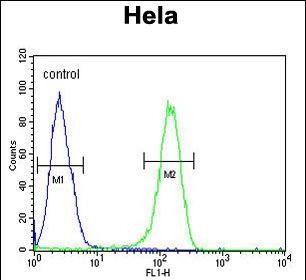ADCY4 Antibody (Center)
Affinity Purified Rabbit Polyclonal Antibody (Pab)
- SPECIFICATION
- CITATIONS
- PROTOCOLS
- BACKGROUND

Application
| FC, WB, E |
|---|---|
| Primary Accession | Q8NFM4 |
| Other Accession | P26770, Q91WF3 |
| Reactivity | Human |
| Predicted | Mouse, Rat |
| Host | Rabbit |
| Clonality | Polyclonal |
| Isotype | Rabbit IgG |
| Calculated MW | 119794 Da |
| Antigen Region | 415-441 aa |
| Gene ID | 196883 |
|---|---|
| Other Names | Adenylate cyclase type 4, ATP pyrophosphate-lyase 4, Adenylate cyclase type IV, Adenylyl cyclase 4, ADCY4 |
| Target/Specificity | This ADCY4 antibody is generated from rabbits immunized with a KLH conjugated synthetic peptide between 415-441 amino acids from the Central region of human ADCY4. |
| Dilution | FC~~1:10~50 WB~~1:1000 E~~Use at an assay dependent concentration. |
| Format | Purified polyclonal antibody supplied in PBS with 0.09% (W/V) sodium azide. This antibody is purified through a protein A column, followed by peptide affinity purification. |
| Storage | Maintain refrigerated at 2-8°C for up to 2 weeks. For long term storage store at -20°C in small aliquots to prevent freeze-thaw cycles. |
| Precautions | ADCY4 Antibody (Center) is for research use only and not for use in diagnostic or therapeutic procedures. |
| Name | ADCY4 |
|---|---|
| Function | Catalyzes the formation of the signaling molecule cAMP in response to G-protein signaling. |
| Cellular Location | Cell membrane; Multi-pass membrane protein. Cytoplasm |
| Tissue Location | Detected in the zona glomerulosa and the zona fasciculata in the adrenal gland (at protein level) |

Thousands of laboratories across the world have published research that depended on the performance of antibodies from Abcepta to advance their research. Check out links to articles that cite our products in major peer-reviewed journals, organized by research category.
info@abcepta.com, and receive a free "I Love Antibodies" mug.
Provided below are standard protocols that you may find useful for product applications.
Background
This gene encodes a member of the family of adenylate cyclases, which are membrane-associated enzymes that catalyze the formation of the secondary messenger cyclic adenosine monophosphate (cAMP). Mouse studies show that adenylate cyclase 4, along with adenylate cyclases 2 and 3, is expressed in olfactory cilia, suggesting that several different adenylate cyclases may couple to olfactory receptors and that there may be multiple receptor-mediated mechanisms for the generation of cAMP signals.
References
Rhim, J.H., et al. Aging Cell 5(6):451-461(2006)
Jiang, G., et al. Am. J. Physiol. Endocrinol. Metab. 284 (4), E671-E678 (2003)
Sunahara, R.K., et al. Mol. Interv. 2(3):168-184(2002)
Ludwig, M.G., et al. J. Recept. Signal Transduct. Res. 22 (1-4), 79-110 (2002)
Cote, M., et al. J. Clin. Endocrinol. Metab. 86(9):4495-4503(2001)
If you have used an Abcepta product and would like to share how it has performed, please click on the "Submit Review" button and provide the requested information. Our staff will examine and post your review and contact you if needed.
If you have any additional inquiries please email technical services at tech@abcepta.com.













 Foundational characteristics of cancer include proliferation, angiogenesis, migration, evasion of apoptosis, and cellular immortality. Find key markers for these cellular processes and antibodies to detect them.
Foundational characteristics of cancer include proliferation, angiogenesis, migration, evasion of apoptosis, and cellular immortality. Find key markers for these cellular processes and antibodies to detect them. The SUMOplot™ Analysis Program predicts and scores sumoylation sites in your protein. SUMOylation is a post-translational modification involved in various cellular processes, such as nuclear-cytosolic transport, transcriptional regulation, apoptosis, protein stability, response to stress, and progression through the cell cycle.
The SUMOplot™ Analysis Program predicts and scores sumoylation sites in your protein. SUMOylation is a post-translational modification involved in various cellular processes, such as nuclear-cytosolic transport, transcriptional regulation, apoptosis, protein stability, response to stress, and progression through the cell cycle. The Autophagy Receptor Motif Plotter predicts and scores autophagy receptor binding sites in your protein. Identifying proteins connected to this pathway is critical to understanding the role of autophagy in physiological as well as pathological processes such as development, differentiation, neurodegenerative diseases, stress, infection, and cancer.
The Autophagy Receptor Motif Plotter predicts and scores autophagy receptor binding sites in your protein. Identifying proteins connected to this pathway is critical to understanding the role of autophagy in physiological as well as pathological processes such as development, differentiation, neurodegenerative diseases, stress, infection, and cancer.



